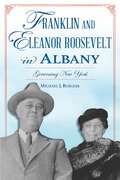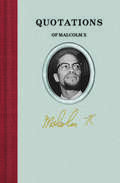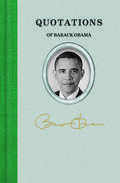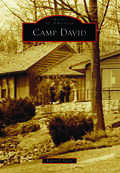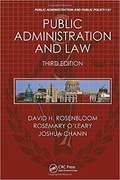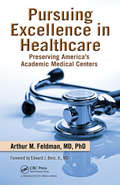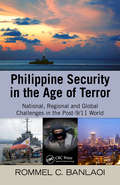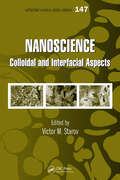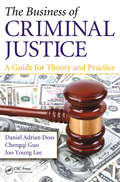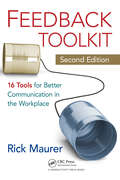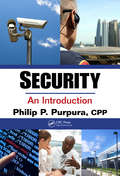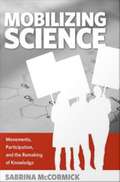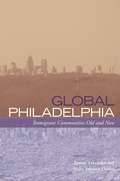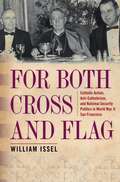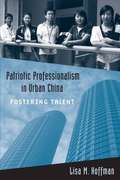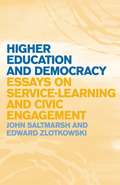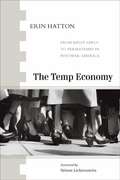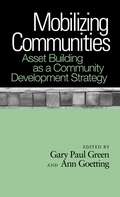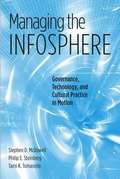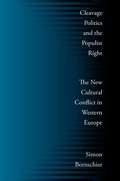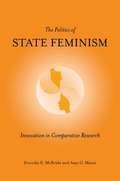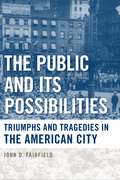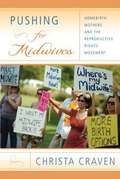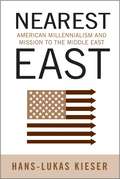- Table View
- List View
Lost Mills of Fulton County (Lost)
by Lisa M. RussellLabor conflicts, arrests, espionage—it was all there at the once ubiquitous mills of Fulton County.Employee records and snatches of paper prove workers spied on each other. Company owners were paranoid about labor unions taking over. Copious documentation, unearthed here by author Lisa M. Russell, brings the workaday drama back to life. These mills sustained families, but exploitation was far from uncommon. When mill workers finally went on strike, there was hell to pay. The company bosses yanked strikers from their shacks. With the help of Governor Talmadge, the National Guard arrested working women with their children. They marched these "criminals" to a former WWI prisoner of war camp that once held enemy German soldiers. Hard to believe this was happening in and around Atlanta in the early 1900s.
Franklin and Eleanor Roosevelt in Albany: Governing New York (The History Press)
by Michael J. BurgessFranklin and Eleanor Roosevelt changed America with a government on the side of the people that put Americans back to work and inspired confidence that the nation could overcome the Great Depression. This is the story of their progressive legacy when FDR was Governor during the era of Prohibition and the advent of radio in the Roaring Twenties, a decade that ended with the Great Depression upending life for most Americans. This is the story of how as Governor of New York he tried the programs that became the New Deal that transformed America. It was the place where his warm, easily relatable voice heard on the radio for the first time created a bond of trust with the public that inspired confidence at a time of great fear.Author Michael J. Burgess reveals the often overlooked history of Franklin and Eleanor Roosevelt in Albany at the helm of the Empire State.
Quotations of Malcolm X (Quotations of Great Americans)
by Malcolm XNotable quotations from Malcolm X This pocketsized hardcover book contains nearly one hundred quotations from African-American Muslim minister and human rights activist, Malcolm X. "It's freedom for everybody or freedom for nobody." -- Malcolm X, King Solomon Baptist Church, Detroit, Michigan, April 12, 1964
Quotations of Barack Obama (Quotations of Great Americans)
by Barack ObamaBe inspired by quotations from Barack Obama, our 44th, and first African-American President of the United States, in this elegant hardcover edition. This collection of motivational and inspirational quotes will make you feel good about America. Featuring a portrait of President Obama on the front cover with his signature printed below in gold foil, this classic collection of Obama quotes will inspire everyone who opens its covers.
Camp David (Images of America)
by Robert P. SavittOriginally named Shangri-La by Franklin D. Roosevelt, today's Camp David was a well-guarded secret until its existence was revealed after World War II. A US Naval facility set on a mountaintop, Camp David's tight security has piqued the curiosity of Americans and foreigners. Prior to the outbreak of war, Roosevelt had access to the nearby presidential yacht as a "getaway" to escape the pressures of life in the White House. After a brief search of nearby locations, a site on Catoctin Mountain in Maryland was chosen as the place for the presidential retreat. It remained Shangri La until President Eisenhower said the name was "just a little fancy for a Kansas farm boy" and renamed it Camp David after his father and grandson in 1953. It has served as retreat for each succeeding president and, in addition to providing rest and relaxation, has been the setting of several historic meetings. Robert P. Savitt writes and lectures on a variety of historical subjects. He holds a doctoral degree from Georgetown University, served in the Departments of Defense and State, and was legislative director for a US senator. Savitt has authored three previous Arcadia Publishing titles.
Public Administration and Law (Public Administration and Public Policy #157)
by Rosemary Oleary Joshua Chanin David RosenbloomSince the first edition of Public Administration and Law was published in 1983, it has retained its unique status of being the only book in the field of public administration that analyzes how constitutional law regulates and informs the way administrators interact with each other and the public. Examining First, Fourth, Fifth, Eighth, and Fourteenth Amendment rights as they pertain to these encounters, it explains how public administrators must do their jobs and how administrative systems must operate in order to comply with constitutional law.
Pursuing Excellence in Healthcare: Preserving America's Academic Medical Centers
by Arthur M. FeldmanMuch as it is with the nation‘s overall healthcare system, the survival of academic medical centers (AMC‘s) is threatened by a combination of economic, cultural, and demographic factors. If AMC‘s are to survive to fill their societal responsibilities, they must adopt a new philosophy. Challenging assumptions and providing the shift in perspective t
Philippine Security in the Age of Terror: National, Regional, and Global Challenges in the Post-9/11 World
by Rommel BanlaoiAs the twelfth most populous nation, the Philippines diverse religious and ethnic population makes it an ideal example of the changing tenet of what is deemed national security post 9/11. Issues previously considered social or public are now viewed as security issues. Food production is now analyzed in the context of food security and environmenta
Nanoscience: Colloidal and Interfacial Aspects (Surfactant Science)
by Victor M. StarovBringing together a prominent roster of 42 leading investigators and their teams, this volume details the wide range of theoretical and experimental knowledge that can be successfully applied for investigating nanosystems. The book provides researchers with a full examination of nano-disperse colloids, homogeneous and heterogeneous nano-structured materials (and their properties), and shelf-organization at the nano-scale. It explores non-linear lectrokinetic phenomena in nano-sized dispersions and nano-sized biological systems. It discusses application aspects of technological processes in great detail, offering scientists and engineers across all fields authoritative commentary on colloid and interface science operating at the nanoscale.
The Business of Criminal Justice: A Guide for Theory and Practice
by Daniel Adrian Doss Chengqi Guo Joo Young LeeThis book represents the manifestation of a new presentation of old perspectives within the discipline of criminal justice. It contains practical considerations of rendering such decisions, it is expected to be an appropriate reference among practitioner personnel.
Feedback Toolkit: 16 Tools for Better Communication in the Workplace, Second Edition
by Nigel Hooper Rick MaurerThis book provides expert guidance on using feedback as a performance improvement tool. It includes many simple tools readers can use to improve feedback in their work unit. The book suggests that feedback works best when the giver and receiver realize that they are in a dance together.
Security: An Introduction
by Philip P. PurpuraToday, threats to the security of an organization can come from a variety of sources- from outside espionage to disgruntled employees and internet risks to utility failure. Reflecting the diverse and specialized nature of the security industry, Security: An Introduction provides an up-to-date treatment of a topic that has become increasingly comple
Mobilizing Science: Movements, Participation, and the Remaking of Knowledge
by Sabrina MccormickMobilizing Science theoretically and empirically explores the rise of a new kind of social movement--one that attempts to empower citizens through the use of expert scientific research. Sabrina McCormick advances theories of social movements, development, and science and technology studies by examining how these fields intersect in cases around the globe. McCormick grounds her argument in two very different case studies: the anti-dam movement in Brazil and the environmental breast cancer prevention movement in the U. S. These, and many other cases, show that the scientization of society, where expert knowledge is inculcated in multiple institutions and lay people are marginalized, gives rise to these new types of movements. While activists who consequently engage in science often instigate new methods that result in new findings and scientific tools, these movements still often fail due to superficial participatory institutions and tightly knit corporate/government relationships.
Global Philadelphia: Immigrant Communities Old and New
by Mary Johnson Takenaka Ayumi OsirimThe racial and ethnic composition of Philadelphia continues to diversify as a new wave of immigrants—largely from Asia and Latin America—reshape the city’s demographic landscape. Moreover, in a globalized economy, immigration is the key to a city’s survival and competitiveness. The contributors to Global Philadelphiaexamine how Philadelphia has affected its immigrants’ lives, and how these immigrants, in turn, have shaped Philadelphia. Providing a detailed historical, ethnographic, and sociological look at Philadelphia’s immigrant communities, this volume examines the social and economic dynamics of various ethnic populations. Significantly, the contributors make comparisons to and connections between the traditional immigrant groups—Germans, Italians, the Irish, Jews, Puerto Ricans, and Chinese—and newer arrivals, such as Cambodians, Haitians, Indians, Mexicans, and African immigrants of various nationalities. While their experiences vary, Global Philadelphia focuses on some of the critical features that face all immigrant groups—intra-group diversity, the role of institutions, and ties to the homeland. Taken together, these essays provide a richer understanding of the processes and implications of contemporary immigration to the area.
For Both Cross and Flag: Catholic Action, Anti-Catholicism, and National Security Politics in World War II San Francisco
by William IsselIn this fascinating, detailed history, William Issel recounts the civil right abuses suffered by Sylvester Andriano, an Italian American Catholic civil leader whose religious and political activism in San Francisco provoked an Anti-Catholic campaign against him. A leading figure in the Catholic Action movement, Andriano was falsely accused in state and federal Un-American Activities Committee hearings of having Fascist sympathies prior to and during World War II. As his ordeal began, Andriano was subjected to a hostile investigation by the FBI, whose confidential informants were his political rivals. Furthermore, the U. S. Army ordered him to be relocated on the grounds that he was a security risk. For Both Cross and Flagprovides a dramatic illustration of what can happen when parties to urban political rivalries, rooted in religious and ideological differences, seize the opportunity provided by a wartime national security emergency to demonize their enemy as 'a potentially dangerous person. ' Issel presents a cast of characters that includes archbishops, radicals, the Kremlin, J. Edgar Hoover, and more to examine the significant role faith-based political activism played in the political culture that violated Andriano's constitutional rights. Exploring the ramifications of this story,For Both Cross and Flagpresents interesting implications for contemporary events and issues relating to urban politics, ethnic groups, and religion in a time of war.
Patriotic Professionalism in Urban China: Fostering Talent
by Hoffman Lisa M.In the post-Maoist era, China adopted a strategy for investing in the “quality” of its people—through education and training opportunities—that created talentedlabor. In her significant ethnographic study, Patriotic Professionalism in Urban China, Lisa Hoffman explains why the development of “human capital” is seen as fundamental for economic growth and national progress. She examines these new urban employees, who were deemed vital to the success of the global city in China, and who hoped for social mobility, a satisfying career, and perhaps a family. Patriotic Professionalism in Urban China addresses the emergence of this urban professional subject in Dalian, a port city in China. Hoffman identifies who these new professionals are, what choices they have made, and how they have remained closely connected with the nation—although not necessarily the Communist party—leading to a new social form she calls “Patriotic Professionalism. ” Hoffman contributes to the understanding of changing urban life in China while providing an analysis of the country’s “late-socialist neoliberalism. ” In the process, she asks pressing questions about how such shifts in urban life reshape cities, impact individual and family decisions, and reflect economic growth in China in tandem with “global” neoliberal practices.
Higher Education and Democracy: Essays on Service-Learning and Civic Engagement
by John Saltmarsh Zlotkowski EdwardHigher Education and Democracyis a collection of essays written over the last ten years on how civic engagement in higher education works to achieve what authors John Saltmarsh and Edward Zlotkowsi consider to be the academic and civic purposes of higher education. These include creating new modes of teaching and learning, fostering participation in American democracy, The development and respect for community and civic institutions, and encouraging the constant renewal all of these dimensions of American life. Organized chronologically, The twenty-two essays in this volume provide "signposts" along the road in the journey of fulfilling the civic purposes of higher education. For the authors, service-learning is positioned as centrally important To The primary academic systems and structures of higher education, departments, disciplines, curriculum, and programs that are central To The faculty domain. Progressing from the general And The contextual to specific practices embodied in ever larger academic units, The authors conclude with observations on the future of the civic engagement movement.
The Temp Economy: From Kelly Girls to Permatemps in Postwar America
by Erin HattonEveryone knows that work in America is not what it used to be. Layoffs, outsourcing, contingent work, disappearing career ladders—these are the new workplace realities for an increasing number of people. But why? In The Temp Economy, Erin Hatton takes one of the best-known icons of the new economy—the temp industry—and finds that it is more than just a symbol of this degradation of work. The temp industry itself played an active role in this decline—and not just for temps. Industry leaders started by inventing the "Kelly Girl," exploiting 1950s gender stereotypes to justify low wages, minimal benefits, and chronic job insecurity. But they did not stop with Kelly Girls. From selling human"business machines" in the 1970s to "permatemps" in the 1990s, the temp industry relentlessly portrayed workers as profit-busting liabilities that hurt companies' bottom lines even in boom times. These campaigns not only legitimized the widespread use of temps, they also laid the cultural groundwork for a new corporate ethos of ruthless cost cutting and mass layoffs. Succinct, highly readable, and drawn from a vast historical record of industry documents, The Temp Economy is a one-stop resource for anyone interested in the temp industry or the degradation of work in postwar America.
Mobilizing Communities: Asset Building as a Community Development Strategy
by Ann Green Gary Paul GoettingAs communities face new social and economic challenges as well as political changes, the responsibilities for social services, housing needs, and welfare programs are being placed at the local government level. But can community-based organizations address these concerns effectively? The editors and contributors toMobilizing Communitiesexplore how these organizations are responding to these challenges, and how asset-based development efforts can be successful. Asset-based development, rather than needs assessment, has become a new paradigm in the community development field over the last fifteen years. Although the approach is widely used by practitioners and promoted by foundations, asset-based development has not been examined critically by researchers until now. Mobilizing Communitiesprovides a conceptual framework and practical guidance to community development practitioners. The editors solicited case studies from a variety of geographic settings, regions and racial/ethnic groups. The communities in the case studies mobilize residents around different forms of community capital (e. g. , financial, cultural, and environmental capital). The contributors examine the role of public participation, the organizational and institutional structure, relationships with governmental officials, and the outcomes and impacts of the asset-based development projects. Contributors include: Lionel J. "Bo" Beaulieu, Sarah Dewees, Michael L. Dougherty, Mark H. Harvey, John (Jody) Kretzmann, Rocío Peralta, Rhonda Phillips, Deborah Puntenney, Stewart Sarkozy-Banoczy, Gordon E. Shockley, and the editors
Managing the Infosphere: Governance, Technology, and Cultural Practice in Motion
by stephen Mcdowell Steinberg Philip Tomasello TamiDrawing on their expertise in geography, political science, international relations, and communication studies, McDowell, Steinberg, and Tomasello investigate specific policy problems encountered as international organizations, corporations, and individual users try to "manage" a space that simultaneously contradicts and supports existing institutions and systems of governance, identity, and technology.
Cleavage Politics and the Populist Right: The New Cultural Conflict in Western Europe
by Simon BornschierA comparative study of how historical cleavages and party strategies interact to shape the fortunes of the populist right in Western Europe
The Politics of State Feminism: Innovation in Comparative Research
by Mcbride Dorothy E. Mazur Amy G.The Politics of State Feminism addresses essential questions of women's movement activism and political change in western democracies. The authors—top gender and politics scholars—provide a comparative analysis of the effectiveness of government agencies and women's movements regarding women’s policy issues—if, how, and why they form a kind of state feminism. The central research questions are examined across five issue areas in thirteen postindustrial democracies in Europe and North America from the 1960s through the early 2000s. The authors explore a range of topics drawn from contemporary theory, interactions between descriptive and substantive representation, and the place of institutions in democratic change. Using the innovative qualitative and quantitative methods employed by the Research Network on Gender Politics and the State, the authors have developed a new body of theories about the role of state feminism and how it can help further women’s rights.
The Public and Its Possibilities: Triumphs and Tragedies in the American City
by John D. FairfieldIn his compelling reinterpretation of American history,The Public and Its Possibilities, John Fairfield argues that our unrealized civic aspirations provide the essential counterpoint to an excessive focus on private interests. Inspired by the revolutionary generation, nineteenth-century Americans struggled to build an economy and a culture to complement their republican institutions. But over the course of the twentieth century, a corporate economy and consumer culture undercut civic values, conflating consumer and citizen. Fairfield places the city at the center of American experience, describing how a resilient demand for an urban participatory democracy has bumped up against the fog of war, the allure of the marketplace, and persistent prejudices of race, class, and gender. In chronicling and synthesizing centuries of U. S. history--including the struggles of the antislavery, labor, women's rights movements--Fairfield explores the ebb and flow of civic participation, activism, and democracy. He revisits what the public has done for civic activism, and the possibility of taking a greater role. In this age where there has been a move towards greater participation in America's public life from its citizens, Fairfield's book--written in an accessible, jargon-free style and addressed to general readers--is especially topical.
Pushing for Midwives: Homebirth Mothers and the Reproductive Rights Movement
by Christa CravenWith the increasing demand for midwives, activists are lobbying to loosen restrictions that deny legal access to homebirth options. In Pushing for Midwives, Christa Craven presents a nuanced history of women’s reproductive rights activism in the U. S. She also provides an examination of contemporary organizing strategies for reproductive rights in an era increasingly driven by “consumer rights. ” An historical and ethnographic case study of grassroots organizing, Pushing for Midwives is an in-depth look at the strategies, successes, and challenges facing midwifery activists in Virginia. Craven examines how decades-old race and class prejudices against midwives continue to impact opposition to-as well as divisions within-women’s contemporary legislative efforts for midwives. By placing the midwifery struggle within a broader reproductive rights context, Pushing for Midwives encourages activists to reconsider how certain political strategies have the potential to divide women. This reflection is crucial in the wake of neoliberal political-economic shifts that have prioritized the rights of consumers over those of citizens-particularly if activists hope to maintain their commitment to expanding reproductive rights for all women.
Nearest East: American Millennialism and Mission to the Middle East
by Kieser Hans-LukasLong before oil interests shaped American interaction with the Middle East, the U. S. had a strong influence on the late Ottoman and post-Ottoman region. Covering the period from approximately 1800 to the 1970s, Hans-Lukas Kieser's compelling Nearest East tells the story of this intimate, identity-building relationship between the U. S. and the Near East. Kieser chronicles how American missionaries worked to implement their belief in Biblical millennialism, enlightened modernity, and a modern Zion-Israel. Millennialism was part of an American identity that constituted itself religiously in the interaction with and the representation of the "cradle of Zion. " As such, "going Near East" was-at least to American evangelical Protestants-in some ways more important than colonizing the American West. However, many Ottoman Muslims felt threatened by the American missionaries perceiving their successful institutions as an estranging challenge from the outside. Measuring the long twisted road from the missionary Zion-builders of the early 19th century to the privileged US-Israeli partnership in the late 20th century,Nearest East looks carefully on both sides of the relationship. Kieser uses a wide range of Ottoman, Turkish, French, German and other sources, unfamiliar to most Anglophone readers, to tell this story that will appeal to historians of all stripes.

